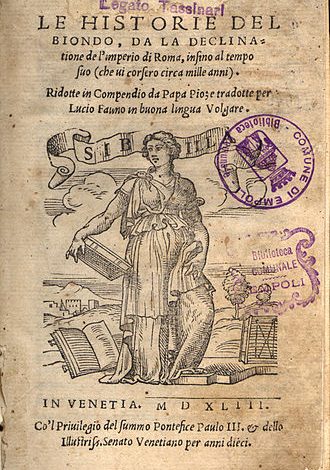Flavio Biondo

Flavio Biondo (Latin Flavius Blondus) (1392 – June 4, 1463) was an Italian Renaissance humanist historian. He was one of the first historians to use a three-period division of history (Ancient, Medieval, Modern) and is known as one of the first archaeologists. Born in the capital city of Forlì, in the Romagna region, Flavio was well schooled from an early age, studying under Ballistario of Cremona. During a brief stay in Milan, he discovered and transcribed the unique manuscript of Cicero’s dialogue Brutus. He moved to Rome in 1433 where he began work on his writing career; he was appointed secretary to the Cancelleria under Eugene IV in 1444 and accompanied Eugene in his exile in Ferrara and Florence. After his patron’s death, Flavio was employed by his papal successors, Nicholas V, Callixtus III and the humanist Pius II.
Flavio published three encyclopedic works that were systematic and documented guides to the ruins and topography of ancient Rome, for which he has been called one of the first archaeologists; subsequent antiquaries and historians built on the foundations laid down by Flavio and by his older contemporary, Poggio Bracciolini. At the time the ruins of ancient Rome were overgrown and unexplored. When in 1420 Bracciolini climbed the Capitol he saw only deserted fields. The Forum, buried in eroded topsoil, was grazed by cows—the Campo Vaccino—and pigs rooted in its unweeded vegetation. Flavio and fellow humanists like Leone Battista Alberti began to explore and document the architecture, topography and history of Rome, and in the process revived a vision of Rome’s former glory.
Flavio Biondo’s gravestone in Santa Maria in Aracoeli, Rome
Flavio’s first work was De Roma instaurata (Rome Restored, 3 vols., 1444–1448), a reconstruction of ancient Roman topography. It was and remains a highly influential humanist vision of restoring Rome to its previous heights of grandeur by recreating what Rome used to look like based on the ruins which remained. This work was the first systematic and well documented guide to the ruins of Rome, or indeed any ancient ruins.
The second was the highly popular De Roma triumphante (Rome Triumphant, 1479) about pagan Rome as a model for contemporary governmental and military reforms. The book was highly influential in reviving Roman patriotism and respect for ancient Rome, while presenting the papacy as a continuation of the Roman Empire.
